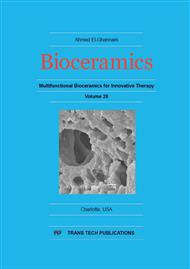[1]
Y. Mizutani, N. Maeda, I. Ohnaka, Y. Waku, H. Yasuda, Journal of Crystal Growth, 244 (2002) 244-384.
DOI: 10.1016/s0022-0248(02)01655-x
Google Scholar
[2]
W. Q. Li, L. Gao, NanoStructured Materials, 11 (1999) 1073-1080.
Google Scholar
[3]
T. A. Parthasarathy, T. Mah, L. E. Matson, Journal of Ceramic Processing Research 5 (2004) 380-390.
Google Scholar
[4]
Y. Waku, N. Nakagawa, T. Wakamoto, H. Otsubo, K. Shimizu, Y. Kohtoku, Journal of Materials Science, 33 (1998) 1217-1225.
DOI: 10.1023/a:1004486303958
Google Scholar
[5]
H. Wang, L. Gao, Ceramics International 27 (2001) 721-723.
Google Scholar
[6]
H. Yasuda, I. Ohnaka, Y. Mizutani, Y. Waku, Science and Techn. of Adv. Mater. 2 (2001)67-71.
Google Scholar
[7]
T. V. Thamaraiselvi, S. Rajeswari, Biological Evaluation of Bioceramic Materials - A Review, Trends Biomater. Artif. Organs. 18 (1) (2004) 9-17.
Google Scholar
[8]
J. P. López, Alumina, Zirconia, and Other Non-oxide Inert Bioceramics, Bio Ceramics with Clinical Applications, ed M. Vallet-Regí, John Wiley & Sons, Ltd, UK. 2014, pp.153-173.
DOI: 10.1002/9781118406748.ch6
Google Scholar
[9]
A. Aherwar, A. K Singh, A. Patnaik, Current and future biocompatibility aspects of biomaterials for hip prosthesis, AIMS Bioengineering. 3 (1) (2015) 23-43.
DOI: 10.3934/bioeng.2016.1.23
Google Scholar
[10]
A. H. De Aza, J. Chevalier, G. Fantozz, M. Schehl, R. Torrecillas, Crack growth resistance of alumina, zirconia and zirconia toughened alumina ceramics for joint prostheses, Biomaterials. 23 (2002) 937–945.
DOI: 10.1016/s0142-9612(01)00206-x
Google Scholar
[11]
S. M. Kurtz, S. Kocagöz, C. Arnholt, R. Huet, M. Ueno, W. L. Walter, Advances in Zirconia Toughened Alumina Biomaterials for Total Joint Replacement, J Mech Behav Biomed Mater. 31 (2014) 107–116.
DOI: 10.1016/j.jmbbm.2013.03.022
Google Scholar
[12]
J. Chevalier, What future for zirconia as a biomaterial?, Biomaterials. 27 (2006) 535–543.
DOI: 10.1016/j.biomaterials.2005.07.034
Google Scholar
[13]
J. Chevalier, S. Grandjean, M. Kuntz, G. Pezzotti, On the kinetics and impact of tetragonal to monoclinic transformation in an alumina/zirconia composite for arthroplasty applications, Biomaterials. 30 (2009) 5279–5282.
DOI: 10.1016/j.biomaterials.2009.06.022
Google Scholar
[14]
J. Chevalier, What future for zirconia as a biomaterial, Biomaterials (2006) 27 535–543.
DOI: 10.1016/j.biomaterials.2005.07.034
Google Scholar
[15]
B. Cales, Zirconia as a sliding material: histologic, laboratory, and clinical data, Clin Orthop Relat Res. 379 (2000) 94-112.
DOI: 10.1097/00003086-200010000-00013
Google Scholar
[16]
I. C. Clarke, M. Manaka, D. D. Green, P. Williams, G. Pezzotti, Y. H. Kim, M. Ries, N. Sugano, L. Sedel, C. Delauney, B. B. Nissan, T. Donaldson, G. A. Gustafson, Current status of zirconia used in total hip implants, The Journal of bone and joint surgery. American. 85-A(4) (2003).
DOI: 10.2106/00004623-200300004-00009
Google Scholar
[17]
L.C. De Jongue, M. N. Rahaman, Sintering of Ceramics, Handbook of advanced ceramics, Elsevier Inc, 2003, pp.187-264.
Google Scholar
[18]
M. H. Prado da Silva, A.F. Lemos, J.M. Ferreira, M.A. Lopes, J.D. Santos, Production of porous biomaterials based on glass-reinforced hydroxyapatite composites, Key Eng Mater. 230-232 (2002) 483-486.
DOI: 10.4028/www.scientific.net/kem.230-232.483
Google Scholar
[19]
M. H. Prado da Silva, A. F. Lemos, I. R. Gibson, J. M. F. Ferreira, J. D. Santos, Porous glass reinforced hydroxyapatite materials produced with different organic additives, J Non-Cryst Solids. 304 (2002) 286–292.
DOI: 10.1016/s0022-3093(02)01036-0
Google Scholar


